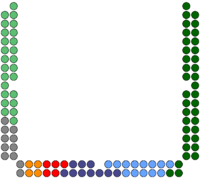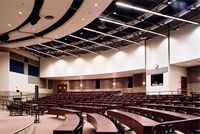Hérvynsken: Difference between revisions
No edit summary |
mNo edit summary |
||
| Line 55: | Line 55: | ||
The '''''Hérvynsken''''' is the {{wp|bicameral}} national {{wp|legislature}} of [[Seketan]]. It is composed of the [[State Council]] as its upper house and the [[Commons Council (Seketan)|Commons Council]] as its lower house. Both chambers are based in the [[Hérvynsken Building]] in [[Conelibek]]. | The '''''Hérvynsken''''' is the {{wp|bicameral}} national {{wp|legislature}} of [[Seketan]]. It is composed of the [[State Council]] as its upper house and the [[Commons Council (Seketan)|Commons Council]] as its lower house. Both chambers are based in the [[Hérvynsken Building]] in [[Conelibek]]. | ||
The origins of the ''Hérvynsken'' trace to the ''[[Concilium Secetan]]'', the first advisory council of the [[Kingdom of Seketan]]. [[Old Seketese literature]] refers to the council's founding during the reign of [[Moress II]], the first [[King of Seketan]]. Its functions and influence as an institution fluctuated greatly until the 14th century; the [[Charter of Provinces]] signed in 1380 guaranteed {{wp|rights}} for the {{wp|nobility}} and [[Secenic duchies|dukes of Seketan]]. During the [[Nelborne Reformation]], the [[Noble Revolt]] of 1537 led [[Fejer IV|King Fejer IV]] to establish the '' | The origins of the ''Hérvynsken'' trace to the ''[[Concilium Secetan]]'', the first advisory council of the [[Kingdom of Seketan]]. [[Old Seketese literature]] refers to the council's founding during the reign of [[Moress II]], the first [[King of Seketan]]. Its functions and influence as an institution fluctuated greatly until the 14th century; the [[Charter of Provinces]] signed in 1380 guaranteed {{wp|rights}} for the {{wp|nobility}} and [[Secenic duchies|dukes of Seketan]]. During the [[Nelborne Reformation]], the [[Noble Revolt]] of 1537 led [[Fejer IV|King Fejer IV]] to establish the ''Hérvynsken'', establishing Seketan as one of the world's first {{wp|Parliamentary monarchy|parliamentary monarchies}}. In 1673, a dispute over the annexation of Tjrebian land prompted King [[Elysa II]] to agree to create two chambers within the ''Hérvynsken'', the [[Commons Council (Seketan)|Commons Council]] and the [[Royal Council]]. When Seketan entered a personal union with [[Kingdom of Alquiya|Alquiya]] in 1765, it was the ''Hérvynsken'' who approved and gave their consent to the Alquiyan monarch to take the throne, placing themselves as integral to Seketan's sovereignty. | ||
In 1884 King [[Fjedor IV and II|Fjedor II]] announced the establishment of the [[Nelbec Empire|Empire of Alquiya and Seketan]], later the Nelbec Empire, with the ''Hérvynsken'' sending representatives to the first Imperial conference for Seketan. Within the imperial framework, the institution was positioned as the supreme authority in Seketan, only supplanted by the Emperor himself, and therefore had the power to enact laws within the Kingdom of Seketan regarding domestic affairs. In 1892, the Royal Council was reformed into the [[State Council]] to represent the reorganized [[Provinces of Seketan|provinces]]. In [[1914 Seketese general election|1914]], the nationalist [[Kjedorate Party]] won a majority of seats, putting the ''Hérvynsken'' in conflict with the empire at large. The government established the [[Military-Civilian Council]]. After the [[collapse of the Nelbec Empire]], the ''Hérvynsken'' became the legislature of the [[First Seketese Republic]]. After the [[Seketese Civil War]], the ''Hérvynsken'' governed Seketese provinces excluding [[Wilskland]] under a [[Second Seketese Republic|federal government]]. The federation with Wilskland was [[Third Seketese Republic|dissolved in 1945]] and was reorganized into a {{wp|unitary}} state, bring Wilsk representation to the ''Hérvynsken''. | In 1884 King [[Fjedor IV and II|Fjedor II]] announced the establishment of the [[Nelbec Empire|Empire of Alquiya and Seketan]], later the Nelbec Empire, with the ''Hérvynsken'' sending representatives to the first Imperial conference for Seketan. Within the imperial framework, the institution was positioned as the supreme authority in Seketan, only supplanted by the Emperor himself, and therefore had the power to enact laws within the Kingdom of Seketan regarding domestic affairs. In 1892, the Royal Council was reformed into the [[State Council]] to represent the reorganized [[Provinces of Seketan|provinces]]. In [[1914 Seketese general election|1914]], the nationalist [[Kjedorate Party]] won a majority of seats, putting the ''Hérvynsken'' in conflict with the empire at large. The government established the [[Military-Civilian Council]]. After the [[collapse of the Nelbec Empire]], the ''Hérvynsken'' became the legislature of the [[First Seketese Republic]]. After the [[Seketese Civil War]], the ''Hérvynsken'' governed Seketese provinces excluding [[Wilskland]] under a [[Second Seketese Republic|federal government]]. The federation with Wilskland was [[Third Seketese Republic|dissolved in 1945]] and was reorganized into a {{wp|unitary}} state, bring Wilsk representation to the ''Hérvynsken''. | ||
Revision as of 01:38, 28 October 2023
This article is incomplete because it is pending further input from participants, or it is a work-in-progress by one author. Please comment on this article's talk page to share your input, comments and questions. Note: To contribute to this article, you may need to seek help from the author(s) of this page. |
Hérvynsken | |
|---|---|
| Type | |
| Type | |
| Houses | State Council Commons Council |
| History | |
| Founded | 1537 |
| Leadership | |
| Structure | |
| Seats | 398 293 Members of Hérvynsken 105 State councellors |
 | |
State Council political groups | Government (26)
Confidence and Supply (10) Opposition (120)
|
 | |
Commons Council political groups | 'Government (146)
Confidence and Supply (27) Opposition (120)
|
| Elections | |
| |
| |
State Council last election | 6 March 2023 |
Commons Council last election | 4 March 2021 |
| Meeting place | |
 | |
 |
|---|
| This article is part of a series on the politics and government of Seketan |
The Hérvynsken is the bicameral national legislature of Seketan. It is composed of the State Council as its upper house and the Commons Council as its lower house. Both chambers are based in the Hérvynsken Building in Conelibek.
The origins of the Hérvynsken trace to the Concilium Secetan, the first advisory council of the Kingdom of Seketan. Old Seketese literature refers to the council's founding during the reign of Moress II, the first King of Seketan. Its functions and influence as an institution fluctuated greatly until the 14th century; the Charter of Provinces signed in 1380 guaranteed rights for the nobility and dukes of Seketan. During the Nelborne Reformation, the Noble Revolt of 1537 led King Fejer IV to establish the Hérvynsken, establishing Seketan as one of the world's first parliamentary monarchies. In 1673, a dispute over the annexation of Tjrebian land prompted King Elysa II to agree to create two chambers within the Hérvynsken, the Commons Council and the Royal Council. When Seketan entered a personal union with Alquiya in 1765, it was the Hérvynsken who approved and gave their consent to the Alquiyan monarch to take the throne, placing themselves as integral to Seketan's sovereignty.
In 1884 King Fjedor II announced the establishment of the Empire of Alquiya and Seketan, later the Nelbec Empire, with the Hérvynsken sending representatives to the first Imperial conference for Seketan. Within the imperial framework, the institution was positioned as the supreme authority in Seketan, only supplanted by the Emperor himself, and therefore had the power to enact laws within the Kingdom of Seketan regarding domestic affairs. In 1892, the Royal Council was reformed into the State Council to represent the reorganized provinces. In 1914, the nationalist Kjedorate Party won a majority of seats, putting the Hérvynsken in conflict with the empire at large. The government established the Military-Civilian Council. After the collapse of the Nelbec Empire, the Hérvynsken became the legislature of the First Seketese Republic. After the Seketese Civil War, the Hérvynsken governed Seketese provinces excluding Wilskland under a federal government. The federation with Wilskland was dissolved in 1945 and was reorganized into a unitary state, bring Wilsk representation to the Hérvynsken.
Established in 1537, the Hérvynsken is one of the oldest continuously functioning parliaments in the world. Elections take place every 4 years, or until a snap election is called; they are considered "free and fair", however allegations of irregularities occur.
Current standings
| Party | Commons Council | State Council | |
|---|---|---|---|
| Our Revolution (MO) Mays Omysan |
126 / 293 |
26 / 106
| |
| Socialist Party (SY) Sošyça ynden |
59 / 293 |
25 / 106
| |
| National Conservative Party (CNy) Consyvaþeça Nasijoteça ynden |
27 / 293 |
10 / 106
| |
| Labour and Unionists Cooperative (OeUC) Ocisa e Uninui Cooperative |
17 / 293 |
10 / 106
| |
| Liberal Democratic Party (LDY) Libre democrateça ynden |
20 / 293 |
4 / 106
| |
| Wilsk National Party (WNY) Wyélš Našiyoteka yéden |
9 / 293 |
13 / 106
| |
| Freedom Alliance (FA) | 20 / 293 |
0 / 106
| |
| Green Party (AY) Azen ynden |
6 / 293 |
7 / 106
| |
| Party of Seketan (YaS) Ynden a Secen |
7 / 293 |
0 / 106
| |
| Progressive Party (PY) Progressija ynden |
1 / 293 |
0 / 106
| |
| Fjeska National Party (FNP) | 1 / 293 |
0 / 106
| |
| Independent | 0 / 293 |
11 / 106
| |